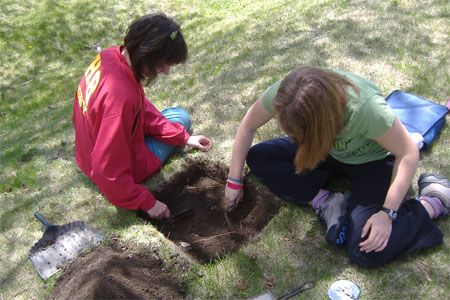 This year’s excavations included a total of 22 students participating through the E=MC² program, and 40 participants through the “Can You Dig It?”© Summer Archaeology Program. The Warden’s Residence on the grounds of Canada’s Penitentiary Museum, was this years site for excavation.
This year’s excavations included a total of 22 students participating through the E=MC² program, and 40 participants through the “Can You Dig It?”© Summer Archaeology Program. The Warden’s Residence on the grounds of Canada’s Penitentiary Museum, was this years site for excavation.
Previous archaeological investigations were conducted in 1996 and 1997 at the southeast corner of the property, where some structural evidence of buildings pre-dating the Warden’s Residence construction of the 1870s was found. The focus for 2006 investigations was the western portion of the property or West Lawn. This area was identified as containing several buildings relating to the military Penitentiary Barracks stables, established as part of the defensive upgrading during the 1837-38 Upper Canada Rebellion period.
The subsequent Warden’s Residence period of use and occupation, starting in the 1870s, saw the naturally sloped environment and quarry pit adjacent to King Street transformed into an elegant terraced garden with stone steps to access each level. An ornamental garden was eventually established on the West Lawn. Test-pitting and excavation of six larger units did not uncover any substantial indications of activity or structures relating to the military use of the area during the 1837-38 Rebellion period or later Fenian raids.
Although it is unknown where the landscaping fill came from, there were certainly indications of building materials including mortar and smaller rubble stones. These may have resulted from demolition of structures in this area, which was likely graded during the terrace construction. Artifacts from the various fill layers indicate a mixed context, although some materials certainly pre-date the 1870s landscaping episode. A good example is the 1842 half penny token and some of the ceramics.
 Further south, significantly larger rubble was encountered beneath one of the former gravel paths. It is believed that this rubble may have served as part of the drainage system most likely installed during the terracing of the gardens in the first half of the 1870s.
Further south, significantly larger rubble was encountered beneath one of the former gravel paths. It is believed that this rubble may have served as part of the drainage system most likely installed during the terracing of the gardens in the first half of the 1870s.
With the small number of excavation units and limited excavation time it was difficult to conduct thorough investigations of this large property. It is therefore still likely that evidence of the military associations with the property might still be encountered.

 This year’s excavations included a total of 22 students participating through the E=MC² program, and 40 participants through the “Can You Dig It?”© Summer Archaeology Program. The Warden’s Residence on the grounds of Canada’s Penitentiary Museum, was this years site for excavation.
This year’s excavations included a total of 22 students participating through the E=MC² program, and 40 participants through the “Can You Dig It?”© Summer Archaeology Program. The Warden’s Residence on the grounds of Canada’s Penitentiary Museum, was this years site for excavation. Further south, significantly larger rubble was encountered beneath one of the former gravel paths. It is believed that this rubble may have served as part of the drainage system most likely installed during the terracing of the gardens in the first half of the 1870s.
Further south, significantly larger rubble was encountered beneath one of the former gravel paths. It is believed that this rubble may have served as part of the drainage system most likely installed during the terracing of the gardens in the first half of the 1870s.